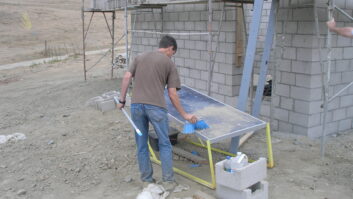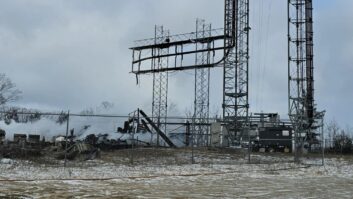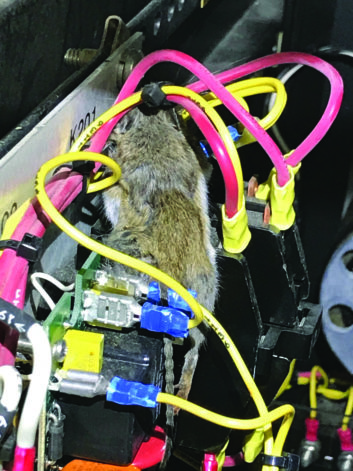
Jim Leedham’s Broadcast Electronics FM35T transmitter was down, although the station air signal was protected by a backup. As he drove to the site, Jim ran through the scenarios of what he might find, as most engineers do.
Once on site, Jim killed the breakers, shorted the components and with a strong trouble lamp looked inside. It didn’t take long to find something that didn’t belong, as you will see in Fig. 1. He quickly removed the intruder and restored the rig to the air.
The rest of Jim’s time was spent seeking to improve his rodent prevention. He plugged a couple of cable pass-throughs at the base of the transmitter. He also inspected the floor and racks for droppings, which would indicate a larger infestation. None found, he spread mothballs and mouse bait to guard against future intruders.
This is the season when rodents seek the comfort of a building. A few steps now can ensure they don’t choose your transmitter building.
***
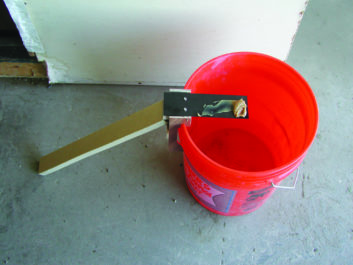
While we’re on the subject of rodent infestation: Wolfram Engineering principal engineer Greg Muir read about the DIY rat trap we described in October. He says he recently discovered a similar “trap” for rodents at one of the sites he maintains.
As pictured in Fig. 2, a “plank” is mounted on a pivot shaft near the edge of a bucket. This plank is held in a horizontal position by a weak magnet, placed underneath, just before the pivot shaft. The unsuspecting mouse heads up the ramp (Fig. 3) and walks out onto the plank to get to the peanut butter. The magnet separates from its keeper, and the plank gives way, dumping the mouse into the water in the bottom of the bucket.
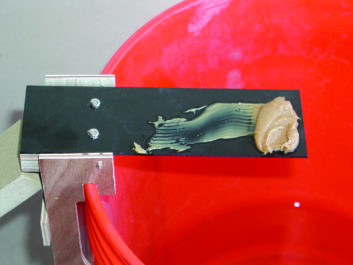
The assembly appears to be a commercially-made item; the Home Depot bucket may suggest the source. Greg says that this rig was in place for a few months and never did dunk a mouse (even though the traditional mouse bait, located in other parts of the room, effectively did its job).
Greg theorizes that the local mice may have served on board ships at some point, and knew full well what a mutiny meant! Arrrrrr, matey.
For sites where traps can be checked daily, Radio World editor Paul McLane prefers humane traps and recommends you Google “humane mouse trap.”
***
From Monday Morning Coffee and Technical Notes — a free e-newsletter from the Alabama Association of Broadcasters, authored by Larry Wilkins, past recipient of the Radio World Excellence in Engineering Award — comes this reminder: By now, all stations should have updated their EAS equipment to handle IPAWS messages correctly.
The deadline was Nov. 8; however, some stations may have taken advantage of what they consider a “60-day extension.” The FCC did not issue an extension, but Part 11 of the rules has always contained a paragraph noting that if an EAS device is not operating normally, the station could operate for up to 60 days while correcting the problem. Larry warns that this is not a reason for delaying your upgrade.
***
Special project engineer and Radio World colleague Dan Slentz is a wealth of broadcast solutions, many of them at low- or no-cost. Dan found a radio news service that provides news content to stations at no charge, while encouraging financial support donations.
Public News Service delivers one newscast per day, updating it if something is breaking. The six-minute newscast has a three- minute “clean out point” with the cue, “This is PNS.”
They also offer both state and regional stories and actualities. The best part, they stay “content neutral,” meaning no “pro” or “anti” anyone. Find it at www.publicnewsservice.org.
***
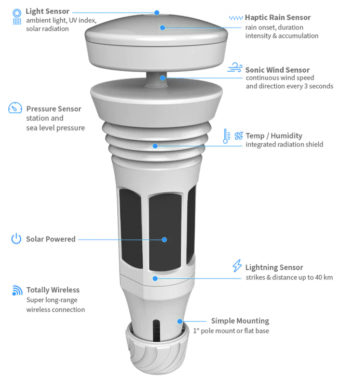
Modern advances allow ordinary folks to install weather stations on their own property. With the advent of smart technology, a company named Weatherflow plans soon to ship its latest weather system, called Tempest.
The Tempest promises to use artificial intelligence to provide accurate, up-to-date weather information and may be helpful at operations where conditions can “turn on a dime.” Two things that set this instrument apart are that it is solar-powered and that it is compact, about the size of a camping lantern. It’s also wireless, so no cabling is necessary.
Google “Weatherflow Tempest.” It is scheduled to be available in retail in April, with early crowdfunding backers seeing theirs sooner. (If you haven’t yet participated in a crowdfunding venture, read up on how they work first.)
See other interesting products (like a tiny wind meter you plug into your smartphone) at weatherflow.com. Current products from the company are available on Amazon.
***
The Society of Broadcast Engineers is promoting a mentoring program for new engineers. Radio World and Workbench heartily support that goal. If you haven’t already, please consider joining SBE, and then inquire about how you can help.
Also, you can mentor others and earn SBE recertification credit by sharing tips here in the pages of Workbench. Send tips and high-resolution photos to [email protected].
John Bisset has spent 50 years in the broadcasting industry and is still learning. He handles western U.S. radio sales for the Telos Alliance. He holds CPBE certification with the SBE and is a past recipient of the society’s Educator of the Year Award.











